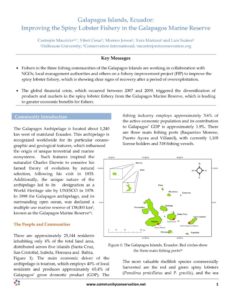
09 May Galapagos Islands, Ecuador
Castejon Mauricio (a.b) , Viteri Cesar (b) , Moreno Jerson (b), Vera Mariana (b) , and Luis Suarez (b).
(a) Dalhousie University; (b) Conservation International
Key Messages
- Fishers in three fishing communities of the Galapagos Islands are working in collaboration with NGOs. Local Management Authorities and other Fishery Improvement Project (FIP) to improve the spiny lobster fishery, which is showing clear signs of recovery after a period of over exploitation.
- The global financial crisis, which concurred between 2007 and 2009, triggered the diversification of products and markets in the spiny lobster fishery from the Galapagos Marine Reserve, which is leading to greater economic benefits of fishery
Community Introduction
The Galapagos Archipelago is located about 1,240 km west of mainland Ecuador. This archipelago is recognized worldwide for its particular oceano-graphic and geological features, which influenced the origin of unique terrestrial and marine ecosystems. Such features inspired the naturalist Charles Darwin to conceive his famed theory of evolution by natural selection, following his visit in 1835. Additionally, the unique nature of the archipelago led to its designation as a World Heritage site by UNESCO in 1978. In 1998 the Galapagos archipelago, and its surrounding open ocean, was declared a multiple use marine reserve of 138,000 km2, known as the Galapagos Marine Reserve(1).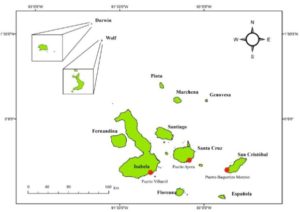
The People and Communities
There are approximately 25,144 residents inhabiting only 4% of the total land area, distributed across five islands (Santa Cruz, San Cristobal, Isabela, Floreana and Baltra, Figure 1). The main economic driver of the archipelago is tourism, which employs 40% of local residents and produces approximately 65.4% of Galapagos’ gross domestic product (GDP). The fishing industry employs approximately 3.6% of the active economic population and its contribution to Galapagos’ GDP is approximately 1.9%. There are three main fishing ports (Baquerizo Moreno, Puerto Ayora and Villamil), with currently 1,105 license holders and 318 fishing vessels.
The most valuable shellfish species commercially harvested are the red and green spiny lobsters (Panulirus penicillatus and P. gracilis), and the sea cucumber (Isostichopus fuscus). They are harvested exclusively by artisanal hookah and skin divers mostly in sub-tidal rocky habitats (Figure 2).
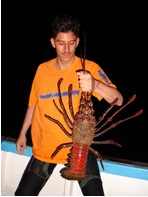
Figure 2: Hooka diver from Puerto Ayora, Santa Cruz Island, with a red spiny lobster (Photo: Mauricio Castrejón)
Of all fishers in the Galapagos, only 42% of them (and 54% of vessels) remain active in the spiny lobster fishery. Of the four fishing cooperatives, one of them, COPROPAG, has shown a long term commitment to improve the spiny lobster fishery.
Conservation and Livelihood Challenges
The overcapitalization of the small scale artisanal fishing fleet, driven by the boom and bust exploitation of the sea cucumber fishery, caused an exponential growth of the number of license holders and vessels between 1999 and 2002. Consequently, fishing effort increased in the spiny lobster fishery leading to its over-exploitation(3). Decreasing trends in abundance and yield (Figure 3) were also caused by the catching of lobsters below the minimum landing size, catch of egg-bearing lobsters, and illegal fishing during closure season (January-August). As spiny lobster stocks declined, the race for fish intensified resulting in more illegal fishing and more restrictive management measures, including implementation of a total allowable catch and reduction of the fishing season from 8 to 4 months.
In addition to overexploitation, the economic performance of the spiny lobster fishery was negatively affected by the global financial crisis which occurred between 2007 and 2009. This crisis reduced the consumption of lobsters in the United States and the European Union – the main foreign markets for Ecuador. In the Galapagos, the sharp worldwide decline in lobster demand produced a price drop of 32% between 2008 and 2009(2).
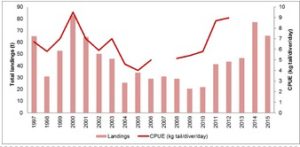
Figure 3: Landings and catch time series from 1997 to 2015(4)
Community Initiative
During the economic crisis, middlemen refused to buy landings at higher prices. This resulted in declines of total fishing effort, catch, and exports to mainland Ecuador by 20%, 23% and 45%, respectively(3).
Galapagos fishers reacted individually to the economic crisis, in three ways:
- Abandoning the fishery
- Diversifying their product by trading whole fresh lobsters instead of lobster tails
- Diversifying their market by selling their product directly to the local hospitality sector and general public instead of middlemen(5).
While the economic crisis was detrimental for Galapagos fishers, it was beneficial for spiny lobster stocks. Two years after the official end of the recession, lobster CPUE (catch per unit effort) and catch increased 91% and 102%, respectively (while fishing effort only increased 6% between 2009 and 2011). Since then, these indicators have remained remarkably high. Price also increased, although it remains below the value registered before 2007.
During this period, technical and scientific assistance has been provided to the Galapagos National Park Service (GNPS) and the local fishing sector, by environmental NGOs (Conservation International and World Wildlife Fund), to improve the management and marketing system of the spiny lobster fishery.
There was also an initiative, led by Conservation International, to design, in a participatory way, a Fishery Improvement Project (FIP) for the spiny lobster fishery. A FIP can be defined as an alliance of multiple fishery stakeholders that come together to agree upon an action plan, which specifies the activities required to facilitate the transition from over-exploited or collapsed fisheries toward fisheries that are ecologically sustainable, economically profitable and socially fair and equitable in a specified timeframe. The FIP for the lobster fishery was created with the participation of representatives of the fishing cooperatives from Santa Cruz, Isabela and San Cristobal, as well as authorities from the GNPS, other government agencies, and researchers from the above-noted environmental NGOs, Charles Darwin Foundation, and universities.
Management strategies were defined, which took into consideration input from local fishers and the results of several studies concerning the status, management and marketing system of the Galapagos spiny lobster fishery(6). As a result, a series of strategies were agreed upon by participants to improve the management of the fishery in an integrated way, including activities to improve the value chain, fishery monitoring and the social capital of fisher´s organizations. These actions have resulted in the diversification of products and markets, resulting in higher revenues for fishers.
Practical Outcomes
Since May 2014, the following concrete actions have been taken to improve the spiny lobster fishery(6):
Stock Assessment: An integrated stock assessment of the red spiny lobster stocks has been recently conducted(7), based on data-poor and traditional assessment methods. Based on these studies, reference points and harvest control rules have been agreed upon for the spiny lobster fishery, using a precautionary “traffic light” approach.
Biological Monitoring: Length and weight data for the spiny lobster, gathered at the three main ports of Galapagos, has improved.
Social Marketing Campaign: Since 2012, one fishing cooperative (COPROPAG) has worked to put in practice a social marketing campaign called “Cuidamos lo nuestro para los nuestros” to encourage local consumption of whole lobsters and the adoption of responsible fishing practices (Figure 4). This initiative has contributed to an increase in the proportion of total production consumed locally at provincial level from 10% to 48% in 2013 (Figure 5). This initiative has been complemented since 2015 with the annual organization of a “Galapagos Lobster Festival” with the support of Santa Cruz Municipality, MAGAP, the Tourism Chamber, Minister of Education, and a local gastronomy school.

Figure 4: Social marketing campaign to promote local consumption of whole lobsters and the adoption of responsible fishing practices in Puerto Ayora, Santa Cruz, Galapagos. Credit: Conservation International-Galapagos Program
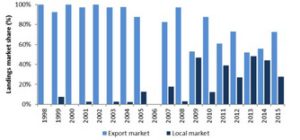
Figure 5: Landing market share for the Galapagos spiny lobster fishery from 1998 to 2015(4)
Local Fishery Certification System: Locally known as Sello Galápagos, the certification system is being created by the local fishing sector, GNPS, World Wildlife Fund, and Conservation International. This is a participatory process that initiated in 2014 and it is expected to conclude in 2017. COPROPAG is receiving technical and economic support to fulfill all the requirements needed to be certified. In turn, COPROPAG has promoted the adoption of Sello Galapagos through social media.
Tourism: Even though lobster ex-vessel prices have rebounded since 2009 increasing from 8 to 9.7 US$ / tail kg, most of lobster production is remaining in the local market, particularly in Puerto Ayora where demand for whole lobsters is higher due to a strong local demand from high-end tourists arriving in increasing numbers (more than 200,000 visitors arrives each year to the islands).
Trading Whole Lobsters
Restructuring of the value chain and diversification of products (now fishers from Puerto Ayora sell whole lobsters instead of only lobster tails) sold at local level are generating strong economic impacts throughout the value chain at Puerto Ayora. Viteri and Moreno(8) found that trading whole lobsters at the local level has improved fishers well-being in two ways:
- In 2013 a whole lobster was worth US$12.24, three times higher than the revenue received from one lobster (US$4.8) when just its tail was marketed. Therefore, fishers obtained higher revenues per lobster
- Fishers’ bargaining power increases when they sell their product in the local market rather than through intermediaries, which helps them to obtain better prices. According tohese authors, more benefits will be obtained gradually as fishers sell a higher percentage of their landings as whole frozen lobster and/or live lobster. These authors estimate that trading exclusively whole lobsters could increase the total revenue of the entire fishery by 30% from US$1.23 million to US$1.6 million.
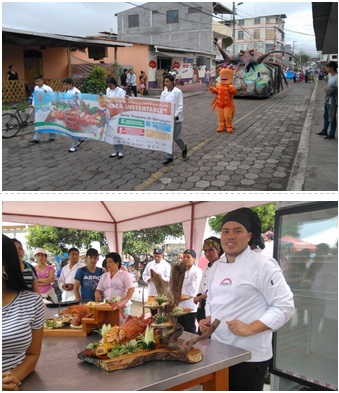
Figure 6: A parade and prepared lobster at the Galapagos Lobster Festival (Photos: Mariana Vera)
Local management authorities, fishing cooperatives and NGOs continue work on improving the management and marketing system of the spiny lobster fishery by the implementation of the FIP agreed upon for this fishery.
References
- Castrejón M, Charles A (2013) Improving fisheries co-management through ecosystem-based spatial management: The Galapagos Marine Reserve. Mar Policy 38:235–245.
- Ramírez J, Castrejón M, Toral-Granda MV (2012a) Mejorando la pesquería de langosta en la Reserva Marina de Galápagos. World Wildlife Fund, Quito, Ecuador.
- Defeo O, Castrejón M, Pérez-Castañeda R, Castilla JC, Gutiérrez NL, Essington TE, Folke C (2016) Co-management in Latin American small-scale shellfisheries: assessment from long-term case studies. Fish Fish 17: 176–192.
- Dirección del Parque Nacional Galápagos (2016) Evaluación integral de la pesquería de langosta espinosa (Panulirus penicillatus y P. gracilis) 2015 en la Reserva Marina de Galápagos”. Informe Técnico. Puerto Ayora, Santa Cruz, Galápagos.
- Castrejón M, Defeo O (2015) Co-governance of small-scale shellfisheries in Latin America: the role of institutional adaptive capacity to cope with climatic and human drivers of change. In: Jentoft S, Chuenpagdee R, (eds) Interact. Gov. small-scale Fish. Glob. Reflections. Springer, New York, p 605-625.
- Castrejón M (2015) Marine Stewardship Council Plus (MSC+) pre-assessment for the spiny lobster (Panulirus penicillatus and P. gracilis) fishery from the Galapagos Marine Reserve. Conservation International. Puerto Ayora, Galapagos, 90 pp.
- Szuwalski CS, Castrejón M, Ovando D, Chasco B (2016). An integrated stock assessment for red spiny lobster (Panulirus penicillatus) from the Galapagos Marine Reserve. Fisheries Research. DOI: 10.1016/j.fishres.2016.01.002
- Viteri C, Moreno J (2014) Estudio de impactos socio-económicos de la comercialización de langosta entera en Galápagos. Puerto Ayora, Galápagos, Ecuador.
Acknowledgements
We are grateful for the financial support provided by the Leona M. and Harry B. Helmsley Charitable Trust to improve the spiny lobster fishery from the GMR. We also acknowledge the long-term support provided by COPROPAG, GNPS, MAGAP and Galapagos Governing Council during the execution of this project.



